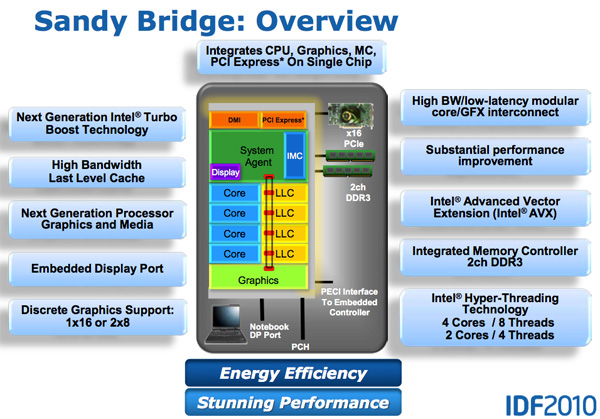Intel's Sandy Bridge Architecture Exposed
by Anand Lal Shimpi on September 14, 2010 4:10 AM EST- Posted in
- CPUs
- Intel
- Sandy Bridge
Final Words
Intel is trying out a new approach to sharing information about its technologies. In an attempt to surprise the market (and potentially positively impact stock price), Intel is keeping details on upcoming products quiet until it gets closer to launch. This is why we didn’t hear about Sandy Bridge until after we were able to preview its performance a couple of weeks ago. I can’t say I’m a fan of the new approach, but it does make things a little more exciting.
And exciting Sandy Bridge is. The CPU architecture itself doesn’t look too revolutionary. These are the sorts of improvements we’ve come to expect from Intel from one generation to the next. The out of order execution window grew as did all associated buffers. Thanks to some significant redesigns in hardware Intel was able to increase branch prediction accuracy and FP execution throughput all while making the chip more energy efficient.
Improved turbo will surely be appreciated. More aggressive turbo bins plus the ability to turbo up above TDP limits for short periods of time will help make PCs feel more responsive even when doing relatively benign tasks. Things like launching applications, loading web pages or just opening new window stand to benefit.

The architecture sounds a lot like Intel simply did Nehalem/Westmere better. Over time you come up with newer, better ways to do things and that’s ultimately what Sandy Bridge looks like - a better, more efficient way to do what Conroe, Nehalem and Westmere did before it.
The more dramatic changes happened outside of the cores. GPU performance is clearly an important Sandy Bridge feature as we’ve already shown. I can’t help but be curious about how far Intel could take its SNB graphics subsystem if it simply scaled up the number of EUs. The media processing engine, particularly with the video transcode support is very exciting. Assuming image quality is maintained and there’s good software support at launch, this could very well be Sandy Bridge’s killer feature. The ability to transcode at over 10x real time on everything from a desktop to a notebook is just awesome. With good software support, SNB’s video transcode engine could effectively stop consumer GPU based video encoding in its tracks. The improved video decode engine is also a welcome addition to the Sandy Bridge architecture.
Connecting it all together we have Sandy Bridge’s ring bus. Generally microprocessor designs don’t undergo such a radical changes unless the design will be used for a while to come. The ring bus sounds very scalable and should support growth in core count, L3 cache and GPU performance. This may end up being the base architecture that takes us from multi-core to many core.

Mobile Sandy Bridge is significantly faster than Arrandale/Clarksfield
Sandy Bridge will ship in Q1 2011 for both notebooks and desktops and from what we’ve heard, pricing will be very compelling. If you're interested in a sneak peak of Sandy Bridge's performance, take a look at our preview here.










62 Comments
View All Comments
iwodo - Tuesday, September 14, 2010 - link
Many questions still not answered, may be Anand could found out for us.1. Were the GPU performance we saw from 6 EU or 12 EU?
2. Where is FMA ( Fused Multiply Add ) ? Will we see it in Ivy Bridge?
3. Can All software developers access the Decoding Engine? We could see many codec being optimized for playback on Intel Hardware Decoder, whether it is fully supported codec or partially supported codec.
4. Hardware Encoder? It is Full Hardware encoder? Free to use for Software Dev?
5. OpenCL not possible?
6. How many % die size is given to Graphics?
7. Gfx Drivers, will Intel commit more resources on drivers update? Or Will they open sources it?
Apart from Sandy Bridge, Looking forward for reports on USB 3.0 situations, LightPeak, Gen 3 SSD.
trivik12 - Tuesday, September 14, 2010 - link
1) I believe it was 12EU part.2) FMA will be introduced with Haswell(next tock). So we have to wait until early 2013 for that.
Foo999 - Tuesday, September 14, 2010 - link
> 2. Where is FMA ( Fused Multiply Add ) ? Will we see it in Ivy Bridge?You can check out the full current (and Ivy Bridge) AVX instructions in the AVX reference manual available from software.intel.com/en-us/avx/
spart - Tuesday, September 14, 2010 - link
1 , 6UE The 12 is only for laptops and high rangesgvaley - Tuesday, September 14, 2010 - link
So, was it playable, I mean Starcraft II?therealnickdanger - Tuesday, September 14, 2010 - link
Yeah, the caption said "310M vs Sandy Bridge" so I assume you could see the settings and frames per second. Details, man, details!!:)
Anand Lal Shimpi - Tuesday, September 14, 2010 - link
Yes, it was playable at medium quality settings. They only had the single player campaign running however.Take care,
Anand
Carleh - Tuesday, September 14, 2010 - link
With BCLK locked, where does that leave the motherboard manufacturers?I mean, what are they left to offer to enthusiasts, if the BCLK is locked? How are they going to differentiate an enthusiast-class motherboard from a mainstream one?
ssj4Gogeta - Tuesday, September 14, 2010 - link
Will they be locking the socket 2011 parts as well?Zoomer - Sunday, September 19, 2010 - link
Sell more bullbozer boards. I was all set to be ready to get a nice Sandy Bridge and overclock it to hell, but now I think I'll get a bulldozer instead.Sure there's the K, but it costs more. That kinda defeats the point, unless the aim is to get a high clk for epeen.